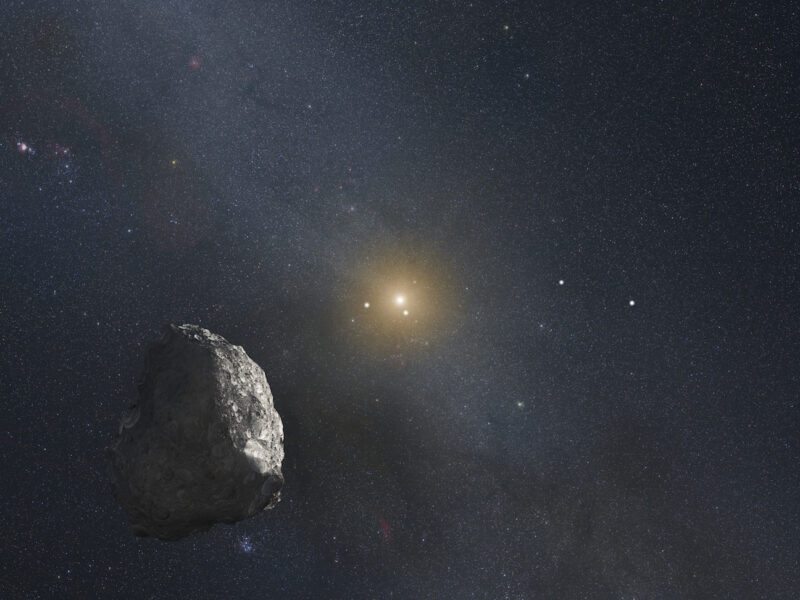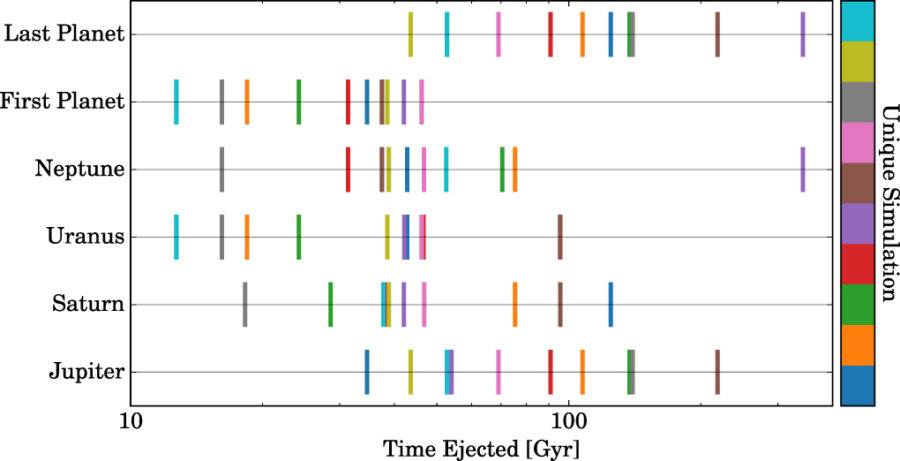Have you ever wondered about the future of our solar system? Astronomers have predicted the effect of the Sun’s expansion on its planets.

ASA / ESA / G. Bacon (STSci)
What thoughts keep you awake at night? If it’s questions about how our solar system is going to end … wow, you really focus on the big picture! But some scientists have wondered the same thing, and they’ve got an answer for you: part of it will be swallowed, and the rest is probably going to disintegrate.
After the Sun Grows Old
Studying the likely fate of our solar system is “one of the oldest pursuits of astrophysics, tracing back to Newton himself,” according to the opening of a recent publication led by Jon Zink (UC Los Angeles). Though the tradition is long, this field is complicated: solving for the dynamical interactions between many bodies is a notoriously difficult problem.
What’s more, it’s not just the dynamics of unchanging objects that need to be taken into account. The Sun will evolve dramatically as it ages off the main sequence, ballooning up to a size that engulfs the orbits of Mercury, Venus, and Earth and losing nearly half of its mass over the next 7 billion years.

Roen Kelly
The outer planets will survive this evolution, but they won’t escape unscathed: since the gravitational pull of the Sun’s mass is what governs the planets’ orbits, our Sun’s weight loss will cause the outer planets to drift even farther out, weakening their tether to our solar system.
What happens next? Zink and collaborators play out the scenario using a series of N-body numerical simulations.
A Solar System No More
The authors’ simulations explore what happens to our outer planets after the Sun consumes the inner planets, loses half its mass, and begins its new life as a white dwarf. Zink and collaborators show how the giant planets will migrate outward in response to the Sun’s mass loss, forming a stable configuration in which Jupiter and Saturn settle into a 5:2 mean motion resonance — Jupiter will orbit five times for every two orbits of Saturn.

Zink et al. 2020
But our solar system doesn’t exist in isolation; there are other stars in the galaxy, and one passes near to us roughly every 20 million years. Zink and collaborators include the effects of these other stars in their simulations. They demonstrate that within about 30 billion years, stellar flybys will have perturbed our outer planets enough that the stable configuration will turn chaotic, rapidly launching the majority of the giant planets out of the solar system.
The last planet standing will stick around for a while longer. But within 100 billion years, even this final remaining planet will also be destabilized by stellar flybys and kicked out of the solar system. After their eviction, the giant planets will independently roam the galaxy, joining the population of free-floating planets without hosts.
Our fate, then, is bleak: the combination of solar mass loss and stellar flybys will lead to the complete dissolution of the solar system, according to these simulations. The good news? This fate is many billions of years in the future — so you needn’t lose sleep over it.
Citation
“The Great Inequality and the Dynamical Disintegration of the Outer Solar System,” Jon K. Zink et al 2020 AJ160 232. doi:10.3847/1538-3881/abb8de
This post originally appeared on AAS Nova, which features research highlights from the journals of the American Astronomical Society.
 4
4









Comments
Rod
November 30, 2020 at 2:25 pm
This was interesting. It is good to make prophecies of the future so far out, none living today will be around to verify the prophecy 🙂 Ejecting whatever planets remain in the solar system after 30 billion years is indeed something. We have a new value for the orbital velocity of the Sun now, 227 km/s and our position from Sgr A*, about 25800 (https://phys.org/news/2020-11-earth-faster-closer-black-hole.html). Using Jean Meeus solution for elliptical orbit, a = 7.92 kpc, e=0.06,that is a period about 214 million years. In 4.5 billion years, the Sun completes ~ 21 revolutions while in 30 billion years, ~ 140 (4.67 revolutions in one billion years). Somehow in the past 21 revolutions since the Sun and planets formed, we managed to avoid passing stars kicking the Earth out of the solar system 🙂 Very good here 🙂
You must be logged in to post a comment.
Tom-Fleming
December 1, 2020 at 10:03 pm
Did the team factor in the spike in chaos when we begin the merger with M31 in a couple of billion years?
You must be logged in to post a comment.
Peter Wilson
December 3, 2020 at 7:56 am
Hopefully, we'll figure out a way to expand Earth's orbit by some kind of leveraged resonance. That'll take millions of years, but it could give Earth an extra billion years of habitability.
You must be logged in to post a comment.
John
December 4, 2020 at 4:43 pm
If we aren't an interstellar species within a few hundreds or thousands of years, we never will be but assuming we are, this little patch of the galaxy will have long been forgotten.
You must be logged in to post a comment.
You must be logged in to post a comment.